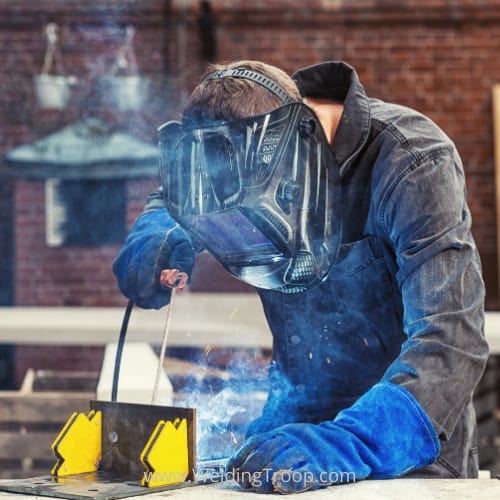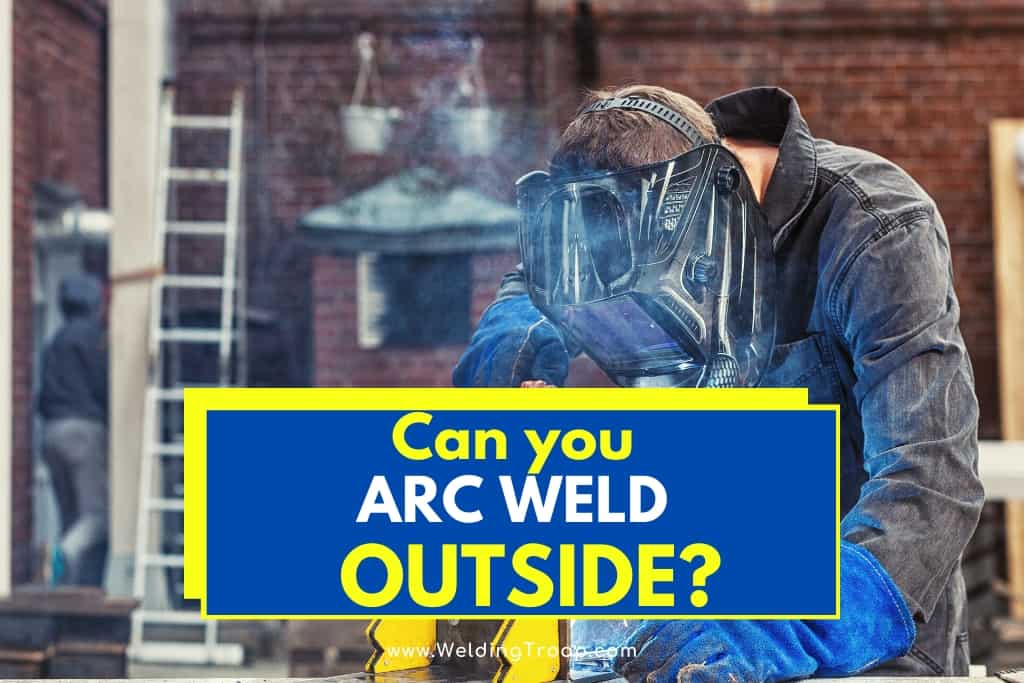There are several requirements for an arc-welding project to be successful. For starters, arc welding outdoors is not the same as arc welding indoors.
Can you arc weld outside? Yes, but you need to make sure you minimize the wind from the environment. Be sure to use a wall or tent to protect the argon gas shield from the wind.
Use several tips to arc weld outside successfully. In addition, it is essential to understand how to prevent drafts when arc welding outside.
Table of Contents
Requirements for Arc Welding Outside
Professional welders use multiple approaches to arc welding outside. The main difference between indoor and outdoor welding is the wind tends to blow the shield when welding outside.
Arc welding outside has its advantages over indoor welding. However, you need to consider outdoor elements like the wind and rain if you want to arc weld outdoors successfully. Welding indoors is easier because the environment is controlled.
It is extremely difficult to control the elements, including wind, sunshine, and rain. On the other hand, arc welding outside is quite different. The conditions are less controlled, and you have to make a few adjustments to maintain the same weld quality.
Special Considerations
Of all the welding options available today, arc welding is one of the most versatile. It provides quality results even in rainy or windy weather.
You do not need a lot of equipment to arc weld. Other welding options, including Mag welding, make moving your workstation outside difficult.
With arc welding, you only need to use a longer power cable. A 20 to 30-meter cable allows you to move from your indoor workshop and weld outside.
With the AC welding machine safely inside your workshop, you do not need to worry about electric shocks when it rains. In addition, it is possible to move your workload outside, especially if welding large metal rods that will not fit inside your shop. Arc welding outside is ideal because you do not need to use a shielding gas.
Before you continue reading, here is an article we wrote about how welding in the wind: Is it Safe to Weld in the Wind? Maximum Wind Velocity
It is not advisable to use a MIG welder outside because the wind can interfere with the shielding gas. Arc welding is less sensitive to dirt or corrosion. You do not have to clean or scrape the rust off metal surfaces to continue welding.
Can You Weld Outside In The Winter?
Yes, you can weld outside in the winter, but you need to take some precautions to avoid negative impacts on your equipment and productivity levels. Cold temperatures can cause issues such as cold cracking when welding, which can be prevented by pre-heating the metal to at least 50 to 60 degrees Fahrenheit before starting the welding process.
It’s also important to check the material specifications before welding in temperatures below freezing and use proper insulation to keep the metal warm while welding. Exposure to extremely low temperatures will make your welds cool off much quicker than usual, which can trigger cracking.
Additionally, it’s recommended to replace the welding lens every six months to a year or as soon as any damage or discoloration is noticed and to avoid using alcohol or ammonia-based cleaners to clean the lens. Instead, use a thin microfiber towel or lens cloth to gently wipe the lens after removing any debris with a brush.
How Do Welders Stay Cool In The Summer?
Welders face a unique set of challenges when it comes to staying cool in the summer heat. To prevent heat illnesses such as heat stroke and dehydration, it is important for welders to take regular breaks.
They should wear lighter clothing and consider using the smallest and shortest power cords possible. Welders can also benefit from taking regular hydration breaks and considering a welding umbrella. However, it is important to note that there are no specific OSHA standards for working in hot conditions, so it’s up to employers to safeguard employees from known significant occupational dangers.
It is also recommended to avoid using alcohol or ammonia-based cleaners when cleaning welding helmets and to replace the welding lens regularly to ensure high-quality vision.
Disadvantages of Arc Welding Outside
Arc welding requires precision work, which is easier to achieve in a closed environment. Workshops are equipped with clamps and other equipment for holding the metals together when welding.
Welding outdoors presents the challenge of keeping everything together as you weld. Metal sheets can be blown away by the wind, which affects the quality of the weld.

Welding outside on a sunny day can be difficult, especially if you want to achieve quality work. It requires you to wear UV canceling goggles to eliminate the sun’s reflection on the metallic surfaces that need to be welded.
Arc welding is a slow and tedious process that requires a skilled hand. It can get too hot or too cold outside when trying to clear a considerable workload. As you arc weld outside, you also have to be careful about toxic fumes produced from the weld.
Carbon dioxide and argon are some of the poisonous gases produced during arc welding. Arc welding also vaporizes traces of toxic metals into the air. Some of the toxic metal emissions produced during arc welding include:
- Arsenic
- Beryllium
- Lead
- Manganese
- Aluminum
These metallic emissions may cause severe damage to the lungs when inhaled.
Tips for Arc Welding Outside Safely
Arc welding requires skill and patience. Therefore, it is not the recommended welding option for newbies.
Like other welding techniques, arc welding follows specific principles. These tips should help you do a clean job when arc welding outside.
Ground your working space
Be sure to connect a grounding clip to the work surface when working with metals. Clip the electrical earthing to metal rods or sheets directly.
The electrical grounding eliminates the risk of electric shock. The next step involves practicing how to strike an arc with the welding gun. Move the tip of the welding stick on the metal surface as if you are striking a match.
Learn More About How to ground a Table or Workplace – Here, you can find an article from our website: Should Welding Tables Be Grounded?
Once you power on the welding gun, the motion produces an electric spark on the metal surface. To start arc welding, lightly press the welding stick on the metal surface. Gently move the welding gun in the right-to-left motion and then backward once the arc forms.
Bevel Edges for Accurate Results
Beveling the edges allows the melting flux to penetrate through the metal for a firmer hold. Do not focus the arc on one spot as this may burn through the metal.
The right-to-left welding motion ensures both metal surfaces are heated. This allows the flux to melt into the bevels and hold the two metal pieces together once it cools.
Align your metal pieces perfectly to weld with precision. Two alignment tools that come in handy are a carpenter’s square and aluminum triangle square. Use a carpenter’s square to align outside joints at a 90 degrees angle accurately. An aluminum triangle square is ideal when aligning inside joints.
Speed Square Hack for Every Welder >> Check out the video below
Practice Tack Welding
Tack welding helps you to join two metal surfaces together temporarily. This frees up your hands to focus more on precise arc welding.
To create a tack, place the two metal sheets together. Ensure both metal rods are correctly aligned if you want to work on the joints. Use a shorter welding stick to create tacks. This enables you to control the welding gun more efficiently.
Gently strike arcs on different places along the surface you want to join—weld on either end of two metal sheets to form a tack.
You can easily weld through the joined surfaces once the tacks holding the two metal pieces are firmly together. Tacks prevent the metal pieces from moving, especially when welding on a windy day.
Do not get discouraged if your tacks are not forming quickly. Tack welding is a skill you master with repetition.
Cleaning Up After Welding
Arc welding sticks tend to leave a bluish residue from the melted flux. Use a welding hammer and wire brush to chip away the slag and the residues from the welded metal.
For a clean job, move the wire brush along the weld line and not across it. A 32 grit-grinding wheel can help you get rid of slag faster. Use primer and paint to add shine to the welded surface. You could also spray an acrylic coating over the welded surface.
Ensure you spray the acrylic coating immediately after welding to prevent rust from forming on the welded surface when arc welding outside.
Personal Protection When Arc Welding Outside
The operator and helpers need to be properly clothed when arc welding outside. Arc welding requires safety gear to protect from heat, UV rays, and sparks produced in the process.
An excellent choice for body protection is a pair of fire-resistant long-sleeved coveralls. Be sure to choose coveralls that do not come with cuffs. In addition, make sure the coveralls do not have worn spots, snags, rips, and tears to minimize the risk of ignition by sparks.
Related Article: Personal Protective Equipment for Welders – PPE | List, and Requirements
Make sure the sleeves and collars of your coveralls are correctly buttoned. In addition, make sure your hands are protected with leather gauntlet gloves. A pair of safety boots should provide excellent protection of the feet.
In case you decide to wear low shoes, be sure to protect your ankles by wearing fire-resistant leggings. Also, wear transparent goggles to protect the eyes. When it comes to arc welding, an excellent welding helmet and hand shield with a filter or cover plates are essential for eye protection.
You may require goggles with darker shades for carbon arc welding or operations that require higher currents. Avoid using helmets with cracked or broken cover and filter plates.
Recommended Reading
Can You MIG Weld in the Rain or when it’s wet?

